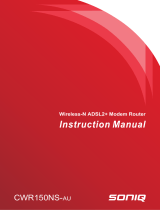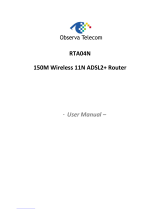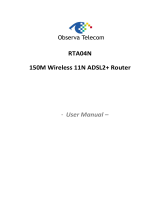Page is loading ...

1
AR-7286WnA / AR-7286WnB
User Manual
6-2013 / v1.0

2
COPYRIGHT
Copyright Edimax Technology Co., Ltd. all rights reserved. No part of this
publication may be reproduced, transmitted, transcribed, stored in a retrieval
system, or translated into any language or computer language, in any form or
by any means, electronic, mechanical, magnetic, optical, chemical, manual or
otherwise, without the prior written permission from Edimax Technology Co.,
Ltd.
Edimax Technology Co., Ltd. makes no representations or warranties,
either expressed or implied, with respect to the contents hereof and
specifically disclaims any warranties, merchantability, or fitness for any
particular purpose. Any software described in this manual is sold or licensed
as is. Should the programs prove defective following their purchase, the buyer
(and not this company, its distributor, or its dealer) assumes the entire cost of
all necessary servicing, repair, and any incidental or consequential damages
resulting from any defect in the software. Edimax Technology Co., Ltd.
reserves the right to revise this publication and to make changes from time to
time in the contents hereof without the obligation to notify any person of
such revision or changes.
The product you have purchased and the setup screen may appear slightly
different from those shown in this QIG. For more information about this
product, please refer to the user manual on the CD-ROM. The software and
specifications are subject to change without notice. Please visit our website
www.edimax.com for updates. All brand and product names mentioned in
this manual are trademarks and/or registered trademarks of their respective
holders.
Edimax Technology Co., Ltd.
Add: No. 3, Wu-Chuan 3
rd
Rd., Wu-Ku Industrial Park, New Taipei City, Taiwan
Tel: +886-2-77396888
Email: sales@edimax.com.tw

3
Contents
1. PRODUCT INTRODUCTION ..................................................................................................................... 5
1.1. PACKAGE CONTENTS ............................................................................................................................ 5
1.2. SYSTEM REQUIREMENTS ....................................................................................................................... 5
1.3. SAFETY PRECAUTIONS .......................................................................................................................... 5
1.4. LED STATUS & BUTTON DEFINITIONS ..................................................................................................... 6
1.5. FEATURES .......................................................................................................................................... 9
2. HARDWARE INSTALLATION .................................................................................................................. 10
3. IP ADDRESS SETTING ............................................................................................................................ 17
3.1. WINDOWS 8 .................................................................................................................................... 17
3.2. WINDOWS 7 .................................................................................................................................... 20
3.3. WINDOWS VISTA .............................................................................................................................. 21
3.4. WINDOWS XP .................................................................................................................................. 22
4. EZMAX SETUP WIZARD ........................................................................................................................ 24
4.1. SETUP WIZARD ................................................................................................................................. 24
4.2. INTERNET CONNECTION TYPE .............................................................................................................. 29
4.2.1. PPoE/PPPoA ......................................................................................................................... 31
4.2.2. Bridge Mode ........................................................................................................................ 32
4.2.3. Dynamic IP Address.............................................................................................................. 33
4.2.4. Static IP ................................................................................................................................ 34
4.3. FIRMWARE UPGRADE ........................................................................................................................ 35
5. WEB CONFIGURATION ......................................................................................................................... 37
5.1. ACCESSING THE ROUTER ..................................................................................................................... 37
5.2. STATUS ........................................................................................................................................... 37
5.2.1. Device Info ........................................................................................................................... 37
5.2.2. System Log ........................................................................................................................... 38
5.2.3. Statistics ............................................................................................................................... 39
5.3. QUICK START ................................................................................................................................... 40
5.3.1. Auto setup by ISP list ............................................................................................................ 42
5.3.2. Bridge Mode ........................................................................................................................ 43
5.3.3. Dynamic IP Address.............................................................................................................. 44
5.3.4. PPPoE/PPPoA ....................................................................................................................... 45
5.4. INTERFACE SETUP .............................................................................................................................. 46
5.4.1. Internet ................................................................................................................................ 46
5.4.2. LAN ....................................................................................................................................... 56

4
5.4.3. Wireless ................................................................................................................................ 60
5.5. ADVANCED SETUP ............................................................................................................................. 62
5.5.1. Firewall................................................................................................................................. 63
5.5.2. Routing ................................................................................................................................. 63
5.5.3. NAT ...................................................................................................................................... 64
5.5.4. QoS ....................................................................................................................................... 68
5.5.5. VLAN .................................................................................................................................... 73
5.5.6. ADSL ..................................................................................................................................... 75
5.6. ACCESS MANAGEMENT ...................................................................................................................... 76
5.6.1. ACL ....................................................................................................................................... 76
5.6.2. Filter ..................................................................................................................................... 77
5.6.3. SNMP ................................................................................................................................... 80
5.6.4. UPnP ..................................................................................................................................... 81
5.6.5. DDNS .................................................................................................................................... 82
5.6.6. CWMP .................................................................................................................................. 82
5.7. MAINTENANCE ................................................................................................................................. 84
5.7.1. Administration ..................................................................................................................... 84
5.7.2. Time Zone ............................................................................................................................. 84
5.7.3. Firmware .............................................................................................................................. 85
5.7.4. SysRestart ............................................................................................................................ 86
5.7.5. Diagnostics ........................................................................................................................... 87
6. TROUBLE SHOOTING ............................................................................................................................ 88
Note: The images/screenshots used in this manual are for reference only –
actual screens may vary according to firmware version. The contents of this
manual are based on the most recent firmware version at the time of writing.

5
1. Product Introduction
1.1. Package Contents
Before you start using this product, please check if there is anything missing in
the package and contact your dealer to claim the missing item(s):
ADSL2+ router (AR-7286WnA or AR-7286WnB)
12V power adapter
1 meter RJ-45 Ethernet cable
1.8M RJ-11 telephone line x 2
Quick installation guide
CD containing setup wizard, user manual & multi-language QIG
Splitter
5dBi antenna x 2
1.2. System Requirements
Recommended system requirements are as follows.
A 10/100 base-T Ethernet card installed in your PC.
A hub or Switch (connected to several PCs through one of the Ethernet
interfaces on the device).
Operating system: Windows 98 SE, Windows 2000, Windows ME,
Windows XP, Windows 7, Windows 8.
Internet Explorer V5.0 or higher, Netscape V4.0 or higher or Firefox 1.5
or higher.
1.3. Safety Precautions
Follow the following instructions to prevent the device from risks and
damage caused by fire or electric power:
Use volume labels to mark the type of power.
Use the power adapter included within the package contents.
Pay attention to the power load of the outlet or prolonged lines. An
overburdened power outlet or damaged lines and plugs may cause an
electric shock or fire. Check the power cords regularly. If you find any
damage, replace it at once.
Proper space left for heat dissipation is necessary to avoid damage
caused by overheating to the device. The long and thin holes on the
device are designed for heat dissipation to ensure that the device
works normally. Do not cover these heat dissipation holes.

6
Do not put this device close to heat sources or high temperatures. Keep
the device out of direct sunshine.
Do not put this device close to a place where it is damp or wet. Do not
spill any fluid on this device.
Do not connect this device to any PCs or electronic products, other than
those which you are instructed or recommended to do so in the
product’s documentation, by our customer engineers or by your
broadband provider – connecting to incorrect devices may cause a fire
risk.
Place this device on a stable surface.
1.4. LED Status & Button Definitions
Front Panel
LED
Color
Status
Description
Power
Green
On
ADSL2+ router is on.
Off
ADSL2+ router Is off.
Red
On
ADSL broadband initial self-test failed or upgrading
firmware.
ADSL
Green
On
ADSL line is synchronized and ready to use.
Slow Flashing
ADSL synchronization failed ( please refer to
Note i. below)
Quick Flashing
ADSL negotiation is in progress.

7
Internet
Green
On
Internet connected in router mode
Flashing
Internet activity (transferring/receiving data) in
router mode.
Off
Device in bridged mode.
Red
On
Internet not connected in router mode
(Please refer to Note ii. below).
LAN1–4
Green
On
LAN port connected.
Flashing
LAN activity (transferring/receiving data).
Off
LAN port not connected.
WLAN
Green
On
Successful WLAN connection.
Flashing
WLAN activity (transferring/receiving data).
Off
WLAN connection failed.
WPS
Green
Off
WPS is disabled.
Flashing
WPS is enabled and waiting for client to negotiate.
Note i. If the ADSL LED is off, please check your Internet connection.
Refer to A. Hardware Installation for more information
about how to connect the router correctly. If all connections
are correct, please contact your ISP to check if there is a
problem with your Internet service.
ii. If the Internet LED is red, please check your ADSL LED first.
If the ADSL LED is off, refer to Note 1. If the green ADSL LED
is ON, please check your Internet configuration. You may
need to check with your ISP that your Internet is configured
correctly.

8
Rear Panel
Item
Description
Power On/Off
Button
Switches the router on or off.
Power
Power port for included 12V power adapter.
Wireless
On/Off Button
Switch the wireless signal on or off.
WPS Button
Activate WPS (Wi-Fi Protected Setup)
LAN 1–4
RJ-45 Ethernet ports 1–4.
Reset Button
Hold for less than 5 seconds to restart the device, and hold for more
than 10 seconds to reset the device to factory default settings.
Line
RJ-11 port for standard telephone line.

9
1.5. Features
The device supports the following features:
Various line modes
External PPPoE dial-up access
Internal PPPoE/PPPoA dial-up access
1483Bridged/1483Routed with dynamic ip or static ip
Multiple PVCs (8 PVCs supported)
DHCP server/relay
Static route
Network Address Translation(NAT)
DMZ
Virtual Server
Universal plug and play (UPnP)
Dynamic Domain Name Server(DDNS)
One-level password and username
Network Time Protocol(NTP)
Firmware upgrading through Web, TFTP, or FTP
Resetting to factory defaults through Reset button or Web
Diagnostic test
Web interface
Telnet CLI
IP/MAC/URL Filter
Application layer service
QOS
Port binding

10
2. Hardware Installation
1. Connect the ADSL line.
Connect the line port of the router of the device to the modem interface of a
splitter using a telephone cable. Connect a telephone to the Phone interface
of the splitter using a telephone cable. Connect the Line interface of the
splitter to your existing, incoming line.
The splitter has three interfaces:
Line: Connect to a wall phone jack (RJ-11 jack).
Modem: Connect to the ADSL jack of the device.
Phone: Connect to a telephone set.
2. Connect the router to your LAN network.
Connect the LAN interface of the router to your PC, hub or switch using an
Ethernet cable.
Note:
Use twisted-pair Ethernet cables to connect the router to a hub or
switch.

11
3. Connect the power adapter to the router.
Plug one end of the power adapter into a wall outlet and connect the other
end to the 12V interface of the device.
The following diagrams show how to correctly connect the router, PC,
splitter and the telephone sets under two different configurations:
Configuration 1
0 shows the correct connection of the router, PC, splitter and the telephone
sets, with no telephone set placed before the splitter.
Figure 1 –Connection diagram
(Without connecting telephone sets before the splitter)

12
Configuration 2
0 shows the correct connection when a telephone set is installed before the
splitter.
Figure 2 - Connection diagram
(Connecting a telephone set before the splitter)
Note:
When Configuration 2 is used, the filter must be installed close to the
telephone cable. Do not use the splitter to replace the filter.
Installing a telephone directly before the splitter may lead to failure of
connection between the device and the central office, or failure of Internet
access, or slow connection speed. If you really need to add a telephone set
before the splitter, you must add a micro filter before a telephone set. Do
not connect several telephones before the splitter or connect several
telephones with the micro filter.
4. Check the ADSL LED status.
Please check the ADSL LED on the front panel. This light indicates the status of
your ADSL broadband through your telephone line. If the light is on, you can
continue setup. However if the light is flashing, there is no broadband line
detected. Please call your Internet Service Provider (ISP) and inform them
about the flashing ADSL light to resolve the issue.

13
5. Firewall settings.
Please turn off all personal firewalls before you continue the setup – firewalls
can block communication between your PC and router.
Note: You must use the power adapter included in the package with the
router, do NOT attempt to use a third-party power adapter.
6. PC LAN IP configuration.
Configure your PC’s LAN settings to automatically obtain an IP address from
the router by following the steps below:
1. Click “Start” and then select “Control Panel”.
2. Click “Switch to Classic View” in the top left to show additional setting
icons.

14
3. Locate the “Network Connections” icon and double-click to open
network connection settings.
4. Select the “Local Area Connection” icon and right-click it to open the
sub-menu, then select “Properties”.

15
5. Select “Internet Protocol (TCP/IP)” and then click “Properties”
6. Ensure that “Obtain an IP address automatically” and “Obtain DNS
server address automatically” are selected and then press “OK”.

17
3. IP Address Setting
To use the router to access the Internet, the PCs in the network must have an
Ethernet adapter installed and be connected to the router either directly or
through a hub or switch. The TCP/IP protocol of each PC must be installed and
the IP Address of each PC has to be set in the same subnet as the router.
The router’s default IP Address is 192.168.2.1 and the subnet mask is
255.255.255.0. PCs can be configured to obtain IP Address automatically
through the DHCP Server of the router or a fixed IP Address in order to be in
the same subnet as the router. By default, the DHCP Server of the router is
enabled and will dispatch IP Address to PC from 192.168.2.100 to
192.168.2.200. It is strongly recommended to set obtaining IP address
automatically.
This section shows you how to configure your PC so that it can obtain an IP
address automatically for either Windows 95/98/Me, 2000 or NT operating
systems. For other operating systems (Macintosh, Sun, etc.), please follow the
manual of the operating system. The following is a step-by-step illustration of
how to configure your PC to obtain an IP address automatically for Windows 8,
Windows 7, Windows Vista and Windows XP.
3.1. Windows 8
1. From the Windows 8 Start screen, you need to switch to desktop mode.
Click the Desktop icon in the bottom left of the screen.

18
2. Click the Network icon and then select Open Network and Sharing
Center to open the Network and Sharing Center window.
3. Click Ethernet to open the Ethernet Status window, and then select
Properties. The Local Area Connection window will appear.

19
4. Check your list of Network Components. Select Internet Protocol Version 4
(TCP/IPv4) and click the Properties button.
5. In the Internet Protocol Version 4 (TCP/IPv4) Properties window, select
Obtain an IP address automatically and Obtain DNS server address
automatically as shown on the following screen.

20
6. Click OK (shown above) to confirm the setting. Your PC will now obtain an
IP address automatically from your router’s DHCP server.
Note: Please make sure that the router’s DHCP server is the only DHCP server
available on your LAN.
3.2. Windows 7
1. Click the Start button and select Control Panel. Double click Network and
Internet and click Network and Sharing Center, the Network and Sharing
Center window will appear.
2. Click Change adapter settings and right click on the Local Area Connection
icon and select Properties. The Local Area Connection window will appear.
3. Check your list of Network Components. You should see Internet Protocol
Version 4 (TCP/IPv4) on your list. Select it and click the Properties button.

21
4. In the Internet Protocol Version 4 (TCP/IPv4) Properties window, select
Obtain an IP address automatically and Obtain DNS server address
automatically as shown on the following screen.
5. Click OK to confirm the setting. Your PC will now obtain an IP address
automatically from your router’s DHCP server.
Note: Please make sure that the router’s DHCP server is the only DHCP server
available on your LAN.
3.3. Windows Vista
1. Click the Start button and select Settings and then select Control Panel.
Double click Network and Sharing Center, the Network and Sharing Center
window will appear.
2. Click Manage network connections and right click on the Local Area
Connection icon and select Properties. The Local Area Connection window
will appear.
/



